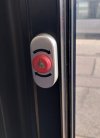KnobbyGB
Member
Apologies for the obscure question, but this has been driving me mad for a few weeks and I know SOMEBODY here will know.
I spent a few days travelling around Norwich recently and it was my first time on the FLIRTS. They seem pretty nice (by modern low-bar standards) but I got to thinking about these windows. Does anyone know their purpose?
My first thought was some kind of emergency exit but they can't be. There's no signage or instructions and they only open inwards, which would be dangerous. There's no mechanism to open them in an emergency anyway, just this "triangular" key socket. This is on the inside only and there are no markings or mechanism on the outside. There seems to be one such window in every carriage. They can't possibly be intended for use when the train has passengers onboard and the main doors are much larger so they can't be for getting equipment in and out.
Am I being stupid and missing the obvious? Any ideas?
I spent a few days travelling around Norwich recently and it was my first time on the FLIRTS. They seem pretty nice (by modern low-bar standards) but I got to thinking about these windows. Does anyone know their purpose?
My first thought was some kind of emergency exit but they can't be. There's no signage or instructions and they only open inwards, which would be dangerous. There's no mechanism to open them in an emergency anyway, just this "triangular" key socket. This is on the inside only and there are no markings or mechanism on the outside. There seems to be one such window in every carriage. They can't possibly be intended for use when the train has passengers onboard and the main doors are much larger so they can't be for getting equipment in and out.
Am I being stupid and missing the obvious? Any ideas?



